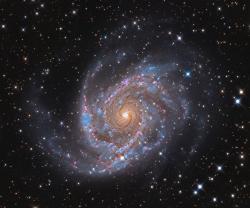
Howdy, Stranger!
It looks like you're new here. If you want to get involved, click one of these buttons!
BlockHead
About
- Username
- BlockHead
- Joined
- Visits
- 257
- Last Active
- Roles
- Member, Administrator
Comments
-
I don't think that is a general approach. Basically you want enough good frames (with a simple/same gradient) that characterizes the background without too much noise. There isn't a general algorithm for this...but you might think of it this way....…
-
Hi Hank, You need to add Hartmut Bornneman's repository to your list. Do not click on the following link... it is a repository that will download his scripts (quite a few). Copy the text and Add this to your Resources->Updates->Manage Reposit…
-
HI Peter, I suspect it ended up in Horizons. (Since it was much harder.)I am guessing it is this one: https://www.adamblockstudios.com/articles/HDRMT_04 -the Blockhead
-
Yes, this is the LRGB challenge. I talk about this in a number of places in my videos. They key is to not have the luminance too bright initially and adjust the contrast of the color image. In your case your color image is too dark. You must have ev…
-
This image is strongly biased in blue (probably due to Alnitak unless you did this with the moon in the sky.)The areas between the reds (where it is strongly blue) are the neutral regions. The horsehead is also mostly neutral in color. You certainly…
-
The moon!!!!Yes..this would contribute quite a bit. The T-shirts are also an issue.You have number of avenues to pursue to minimize this issue.May I use your image for a quick demonstration of DBE on my site? -the Blockhead
-
Loved it!!-the Blockhead
-
Hi Alex, Assuming you do not have a meridian flip in your data... (you can't use CometAlign with a flip)- then it is likely the centroid process. If you turn off PSF Fits, it will be a linear fitting of the motion of the comet. You can also force th…
-
What were your DBE setting?Screen shot of your samples and settings... I have a couple of comments... and I am sorry to bring bad news. 1. Your data is poor. The gradients are too bright compared to the object you are trying to capture. You simply n…
-
The subtraction will never be perfect. You are fighting laws of nature and variability here.Just be certain you are subtracting like colors for the operand. You can also try turning off the linear fit and see if that helps. Remember, you will be int…
-
Yes, I sent you an e-mail...-the Blockhead
-
No.. that warning isn't the issue.-the Blockhead
-
The odd number is useful for a median if ever desired... other than that... really not much difference. They are lucky numbers right? Flats contain lots of signal and low noise for the stuff that interests us. If you are doing photometry.. you need …
-
Yes...that sounds about right.Thanks for the follow up.(Don't use cloud drives for any files that are polled either (like cloud sensors)).-the Blockhead
-
It does require some good brain tracking to make sure you are not assuming you are using certain files rather than others. So you opened the file *from the list of files you have in CometAlignment* and you compared this to your operand image? You tu…
-
Well.. you can simply open your reference image (that StarAligned one) that has the comet.Then open your starless integrated image comet (the operand image). If you compare/blink them... they have to be aligned. If not... you made an error. In the p…
-
Unfortunately I originally had a "clever" idea for OSC...that did not work out.So what you see now is less simple than I had originally hoped. The problem is that for drizzle to work (which is necessary), it refers to the original unregistered and *…
-
Great.If you feel I did not make this clear enough in my video- let me know and I will try to add more language.-the Blockhead
-
Subtraction is not perfect because data is variable. You will see in my videos it is not perfect either.That being said, I do suggest that in some cases turning off Linear Fit can help.In addition, there is no rule that states you cannot adjust the …
-
I am concerned there is an error ... Do you see how PI is complaining about the PSF Fitting?Are you 100% certain you clicked on the nucleus of the comet in the three frames? If so... your next step would be to turn off the PSF Fitting... I show in o…
